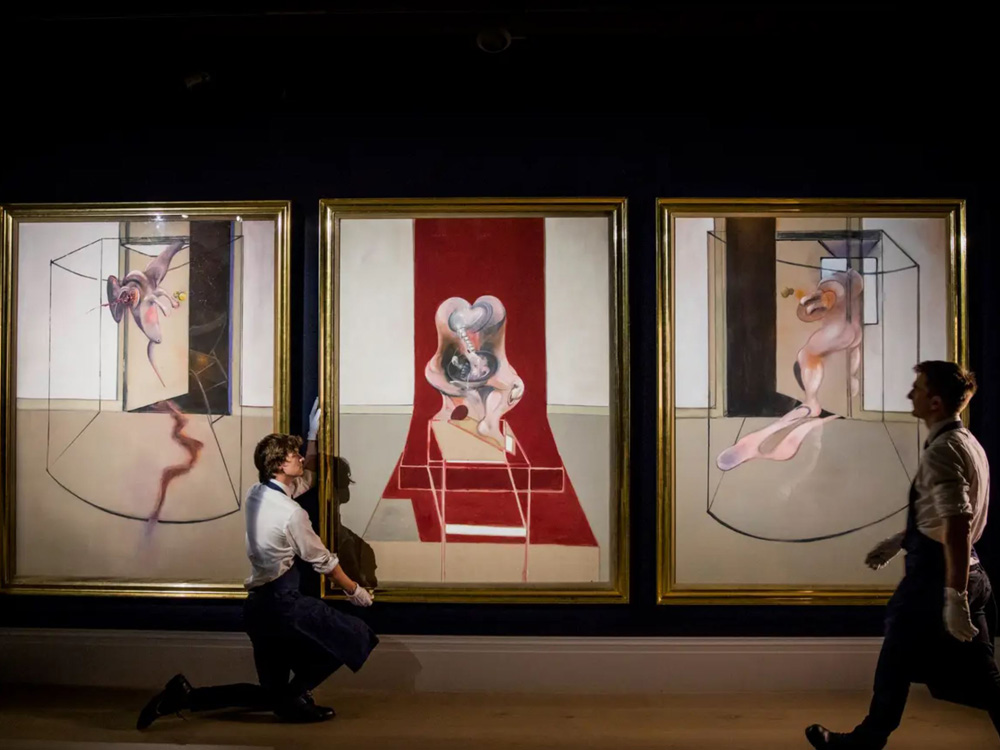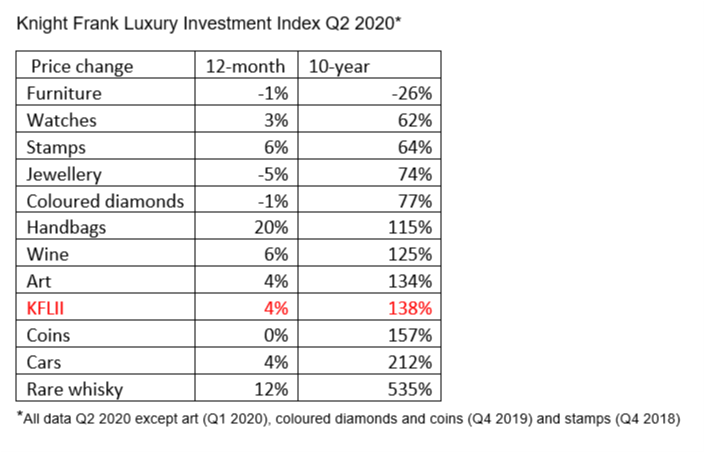The Wealth Report 2020 – Knight Frank Luxury Investment (KFLII) Update
Mixed fortunes for luxury investments during 2020 as pandemic disrupts auction markets
4 minutes to read
When Covid-19 caused equity markets to tank in March some commentators predicted a rush to tangible assets, similar to the one seen in 2008 during the global financial crisis.
So far that hasn’t happened. With many stock markets quickly recovering from the initial slump, and some even hitting record highs, there haven’t been huge volumes of cash flowing into the market for luxury investments.
Even if there was a flight to safety the initial shuttering of live auction sales and the general impact of movement restrictions on buyer activity significantly curtailed some markets.
For example, the Fancy Color Research Foundation, which tracks the market for coloured diamonds was unable to issue quarterly updates for Q1 and Q2 due to a drop in trade.
However, collectors of other asset classes, such as handbags, have been used to buying at online auctions for some time. This may go some way to explaining why bags have continued to see their value grow sharply in 2020, topping our 12-month KFLII rankings.
Art market reined in
The top end of the art market has been particularly badly affected by Covid-19. According to a report by analyst Clare McAndrew published by Art Basel and UBS, gallery sales dropped by 36% in the first half of the year compared with the same period in 2019.
Data from Art Tactic reveals that the top three auction houses – Sotheby’s, Christie’s and Phillips – saw their total sales fall by US$2.8bn in the first six months of the year. The firms, however, saw a sharp upturn in online auctions, generating US$400m more to the end of September than the whole of 2019.

Image courtesy of Sotheby’s
Unsurprisingly, the number of blockbuster sales fell dramatically, although Francis Bacon’s 1981 work Triptych Inspired by the Oresteia of Aeschylus showed that people are still prepared to bid big digitally when it raised US$85m at an online sale by Sotheby’s in New York.
Whisky and wine hold steady
Anecdotally, drinkable investment asset classes have always done well in a downturn, perhaps as their owners have looked to drown their sorrows.
Both rare whisky and wine have shown reasonable gains over the past 12 months.
“We’re seeing a broadening of interest in the fine wine secondary market that is lending support to prices,” says Nick Martin of Wine Owners, which compiles the Knight Frank Fine Wines Icons Index.
“Activity is in both ends of the spectrum - those markets driven by scarcity and those markets led by volume such as vintage Champagne, where demand exceeds supply,” adds Nick.
“But the 2020 growth is unlike that seen following the Lehmann’s crash in 2008. This is not about a flight to tangible assets, as investors who were in the markets in the spring will have seen a much stronger return than wine, especially in tech, healthcare and sustainability sectors.
“We believe this is more about broadening global interest in collectable wines, and the beginnings of more efficient secondary market sales channels, that make it easier to reach a wider audience of buyers,” he explains.
“We have seen an element of stress in the market for bottles over £5,000 due to the current economic climate,” reports Andy Simpson of Rare Whisky 101, compiler of the Knight Frank Rare Whisky Index, which is by some distance the 10-year top performer in KFLII.
“That said, September showed growth across the board. The underpinnings of the market look stronger as we head into the final quarter of 2020 – typically the most buoyant trading period of the year,” adds Andy.
Classic cars not racing
Although a significant number of classic car sales are done privately, the auction market has always provided the razzamatazz for the sector and many sales, including the benchmark auctions Monterey sales, were cancelled or downsized.
“In terms of prices you could probably say the market has plateaued for now,” says Dietrich Hatlapa of HAGI. However, there have still been plenty of deals going on. “A lot of dealers have been very happy and there has been a fair amount of peer to peer activity.

Image courtesy of Gooding & Co
“In times like these cars do represent a degree of freedom. It is nice to be able to jump in your car and just go for a drive without worrying about the pandemic."
One auction that did hit top gear was Gooding & Co’s postponed 15-car sale of a private collection at the Hampton Court Concours of Elegance in September – its first outside the US.
The Passion of a Lifetime sale, originally due to take place in April, saw six world records set including a marque record for a Bugatti Type 59 (pictured) that sold for the equivalent of US$12.7 million.
Two other Bugattis broke the $US5 million mark, while a 1971 Lamborghini Miura P400 SV Speciale fetched US$4.3 million.

Source: Compiled by Knight Frank Research using data from Art Market Research (art, coins, furniture, handbags, jewellery, stamps and watches), Fancy Color Research Foundation (coloured diamonds), HAGI (cars), Rare Whisky 101 and Wine Owners
**KFLII is a weighted average of the performance of the individual asset classes contained within the index